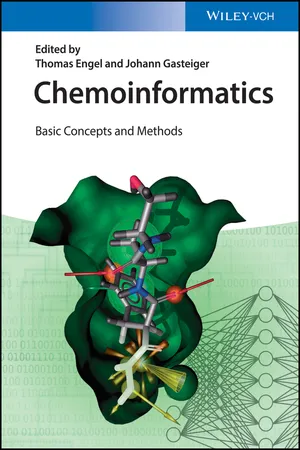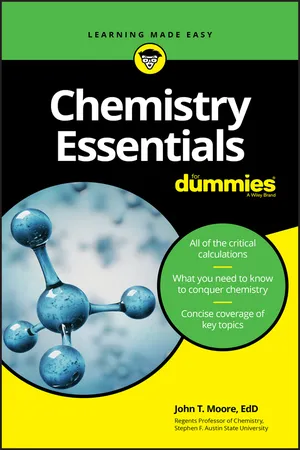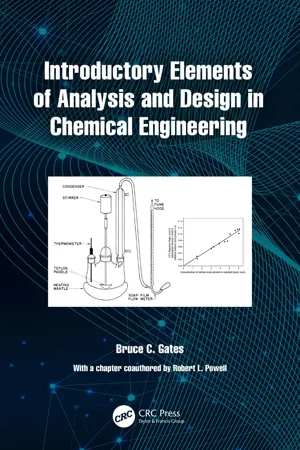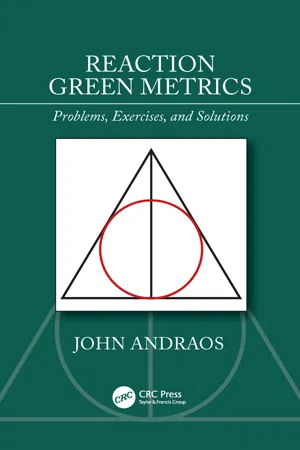Chemistry
Representing Chemical Reactions
Representing chemical reactions involves using chemical equations to depict the reactants and products involved in a chemical change. These equations show the balanced stoichiometry of the reaction, with the number of atoms of each element being conserved. Symbols such as arrows and plus signs are used to indicate the direction and combination of the reactants and products.
Written by Perlego with AI-assistance
Related key terms
Related key terms
1 of 4
Related key terms
1 of 3
6 Key excerpts on "Representing Chemical Reactions"
- eBook - ePub
Green Chemistry and Engineering
A Pathway to Sustainability
- Anne E. Marteel-Parrish, Martin A. Abraham(Authors)
- 2013(Publication Date)
- Wiley-AIChE(Publisher)
5
CHEMICAL REACTIONS
5.1 DEFINITION OF CHEMICAL REACTIONS AND BALANCING OF CHEMICAL EQUATIONS
The concept of molecules and compounds was introduced in Chapter 4. Chemists and chemical engineers manipulate compounds to form new materials that achieve a specific goal or purpose. It is of crucial importance that compounds be mixed in the proper ratios so that the desired reaction can be achieved. The relationship between the compound and its atoms is displayed through the molecular formula, and the chemist uses this information to develop a balanced chemical equation that can properly describe the breaking and forming of bonds in chemical reactions.As mentioned in Chapter 4, a chemical reaction is “a process in which substances (reactants) change into other substances (products) by rearrangement, combination, or separation of atoms.” A chemical reaction is represented by a chemical equation with two sides: one for the reactants and one for the products.The arrow means “forms,” “yields,” “changes to,” or “is/are converted into.”The law of conservation of matter, “matter is neither destroyed nor created,” applies to all atoms in a chemical reaction. As a result, a balanced chemical reaction requires that there must be an equivalent number of atoms of each type on both sides of the equation. Consider the reaction between hydrogen and oxygen to form water, as shown in Equation 5.1 .(5.1 )In Equation 5.1 , we have placed a letter in front of each molecule to represent the stoichiometric coefficient, a multiplying number assigned to the species in a chemical equation in order to balance the equation. Now the challenge is to determine what number each letter in Equation 5.1 represents.Let’s suppose we were producing one molecule of water. In this case, there would be one oxygen atom on the right-hand side of the equation, and to have a balanced chemical equation would require that we have one oxygen atom on the left side. But diatomic oxygen is shown on the left side, and it is not possible to have fractional numbers of molecules. So the smallest number of oxygen molecules on the left side would be one. Based on this analysis, let’s tentatively state that m - eBook - ePub
Chemoinformatics
Basic Concepts and Methods
- Thomas Engel, Johann Gasteiger(Authors)
- 2018(Publication Date)
- Wiley-VCH(Publisher)
4 Representation of Chemical Reactions Oliver Sacher1 and Johann Gasteiger2 1 Molecular Networks GmbH, Neumeyerstraße 28, 90411 Nürnberg, Germany2 Computer‐Chemie‐Centrum, Universität Erlangen-Nürnberg, Nägelsbachstr. 25, 91052 Erlangen, GermanyOutline
- 4.1 Introduction
- 4.2 Reaction Equation
- 4.3 Reaction Types
- 4.4 Reaction Center and Reaction Mechanisms
- 4.5 Chemical Reactivity
- 4.6 Learning from Reaction Information
- 4.7 Building of Reaction Databases
- 4.8 Reaction Center Perception
- 4.9 Reaction Classification
- 4.10 Stereochemistry of Reactions
- 4.11 Reaction Networks
Learning Objectives
- To describe basic models of chemical reactivity.
- To apply simple approaches to quantify chemical reactivity.
- To extract knowledge from reaction information.
- To review reaction classification as an important step in learning from reaction instances.
- To locate the reaction center and its importance in reaction searching.
- To sketch some algorithmic approaches to reaction classification.
- To explain the formal treatment of the stereochemistry of reactions.
4.1 Introduction
Reactions represent the dynamic aspect of chemistry, the interconversion of chemical compounds. Chemical reactions produce the compounds that are sold by industry and that make up a large part of the standard of living of our society, they transform the food that we take up in our body into energy and into other compounds, they provide the energy for surviving in a hostile environment, and they deliver the energy for a large part of our transportation systems.In the laboratory, reactions are run under a variety of conditions, from making large collections of small amounts of compounds through parallel synthesis on well plates, through syntheses in standard three‐necked flasks, all the way to the large‐scale industrial processes in huge reactors. In a mass spectrometer, single molecules break up in the gas phase after ionization through electron impact; in a cell, genes control the synthesis of complex proteins. - eBook - ePub
- John T. Moore(Author)
- 2019(Publication Date)
- For Dummies(Publisher)
Chapter 7Chemical Reactions
IN THIS CHAPTERDifferentiating between reactants and productsFinding out how reactions occurTaking a look at types of reactionsUnderstanding how to balance reactionsFiguring out chemical equilibriumChecking out speeds of reactionIn a chemical reaction, substances (elements and/or compounds) are changed into other substances (compounds and/or elements). You can’t change one element into another element in a chemical reaction — that happens in nuclear reactions, as I describe in Chapter 4 .A number of clues show that a chemical reaction has taken place — something new is visibly produced, a gas is created, heat is given off or taken in, and so on.In this chapter, I discuss chemical reactions — how they occur and how to write a balanced chemical equation. I also tell you about chemical equilibrium and explain why chemists often can’t get the amount of product out of a reaction that they thought they could. And finally, I discuss the speed of reaction.Reactants and Products: Reading Chemical Equations
You create a new substance with chemical reactions. The chemical substances that are eventually changed are called the reactants, and the new substances that are formed are called the products .Chemical equations show the reactants and products, as well as other factors such as energy changes, catalysts, and so on. With these equations, you use an arrow to indicate that a chemical reaction has taken place. Beneath or above this arrow people sometimes indicate that a specific catalyst is used, or acidic conditions or heat is applied, and so on. In general terms, a chemical reaction follows this format:For example, take a look at the reaction that occurs when you light your natural gas range in order to fry your breakfast eggs. Methane (natural gas) reacts with the oxygen in the atmosphere to produce carbon dioxide and water vapor. (If your burner isn’t properly adjusted to give that nice blue flame, you may also get a significant amount of carbon monoxide along with carbon dioxide.) You write the chemical equation that represents this reaction like this: - Bruce C. Gates, Robert L. Powell(Authors)
- 2023(Publication Date)
- CRC Press(Publisher)
5 Chemical Reactors and Chemical ReactionsDOI: 10.1201/9781003429944-5Roadmap
In this chapter, we add a significant new component to our analysis: we bring in chemical change. Now, we go beyond the mass balance as an approach to setting up an analysis, as we take account of the change of one or more components into other components as a result of chemical reaction. The approach is to write a balance equation on molecules and to recognize that molecules, in contrast to mass, are not conserved—they are interconverted in chemical reactions. And so the balance equations we use now are of a new kind—they are not conservation equations, but rather are equations that are like mass balance equations, except that they have a new term, called a generation term, which accounts for the formation (or depletion) of each kind of molecule by chemical reaction. Now the equations are written not in terms of mass per unit time but rather molecules per unit time. By applying these molecule balance equations, we do not abandon the principle of conservation of mass; instead, we just add another kind of equation to the development in addition to the mass balance. We start with a general molecule balance and simplify it for three special cases, corresponding to three ideal chemical reactors—reactors are the vessels in which chemical reactions occur. The molecule balance equations describe the reactors and not the reactions. Later in this chapter, we introduce equations describing the reactions (these are constitutive relationships), and then we combine the equations describing the reactors with the equations describing the reactions, and the results allow us to predict the performance of reactors for particular reactions—and design the reactors.Accounting for Chemical Reactions
In the quantitative developments so far, we have restricted ourselves to physical processes such as flows rather than processes involving chemical change. Now we include chemical reactions as well as flows. By adding reactions to our analysis, we enter territory that is most uniquely associated with chemical engineering, biochemical engineering, and civil and environmental engineering, as well as chemistry. Engineers in these fields are concerned with chemical change and all the equipment and processes used to carry out chemical change. Biochemical engineers deal with production of chemicals from biological raw materials, such as yeast and wood. Environmental engineers deal with purification of waste water, for example. Chemical engineers also deal with these subjects, and also with the production of chemicals and fuels from many natural resources, such as natural gas, petroleum, coal, air, and water, as well as biomass, such as wood. Thus, all these engineers deal with pipes, pumps, and valves in systems that deliver reactants to the vessels in which they are converted; the engineers also deal with the devices used to purify the products of chemical change and deliver them for further processing or use. And, as we see in this chapter, they deal with the vessels in which chemical change takes place. These are called reactors. We now proceed to analyze the performance of several simple (ideal) reactors.- eBook - ePub
Reaction Green Metrics
Problems, Exercises, and Solutions
- John Andraos(Author)
- 2018(Publication Date)
- CRC Press(Publisher)
5 Drawing Chemical StructuresIn this chapter, we address a topic that is never discussed in the undergraduate or graduate curriculum or in chemistry textbooks; namely, how to draw proper chemical structures of reactants and products in any chemical equation so that the equation can be visually read without need for unnecessary mental gymnastics such as reflections, rotations, and translations of chemical structures. As we have seen in Chapter 2, chemists abandoned the fundamental properties of an “equation” from a numerical sense when they replaced the equals sign (“=”) with a reaction arrow (“→”) in writing out chemical transformations. Since that time, generations of chemists have been taught from the outset that the most important concern for a chemist in transcribing a chemical transformation and communicating that information to other chemists is to draw out correct structures for the starting substrate of interest and the resulting product along with annotating the reaction conditions (reagents, solvents, catalysts, reaction temperature, and reaction time) above the reaction arrow. In this practice, structures of by-products are completely ignored. Also, ignored is the relative aspect of how the substrate and product structures appear on the page. Modern chemists who wish to practice green chemistry principles have rediscovered the notion of balancing equations based on element count and charge balance applied to the right- and left-hand sides. This became mandatory in order to determine material efficiency since by-products needed to be specifically identified. Here, we add one more layer to the display of a balanced chemical equation. Since the constituents of a chemical equation are drawings or pictures of chemical structures, the equation also has the component of a visual equation as well as a numerical one. This means that when a visual equation is read from left to right, that is, from the reactant side to the product side, it must be made obvious as far as possible to show which parts of the starting structure remain unchanged and which are different as a consequence of the transformation when comparing the reactant structures with the product structures. In Section 5.1, we introduce the principle of conservation of structural aspect as a guiding principle in depicting how chemical equations are to be displayed. This idea has significant advantages when tracking the target bonds made from step to step throughout a synthesis plan until the final product structure is reached. We also take the time in Section 5.2 to refresh and reinforce key ideas concerning writing reaction mechanisms such as the connection between elementary steps and the final balanced chemical equation, careful usage of the curly arrow notation in tracking electron flow, translating mechanism steps written in linear format to a cyclic format and vice versa, and depicting electrochemically based reaction mechanisms. Target bond mapping discussed in Section 5.3 is at once made obvious by, and is greatly facilitated from, the principle of conservation of structural aspect. Once the target bonds are identified, the oxidation states of the atoms involved in each bond that is made can be tracked as well, and this leads to the determination of a useful parameter called the hypsicity index (HI - Stella Vosniadou, Erik De Corte, Robert Glaser, Heinz Mandl(Authors)
- 2012(Publication Date)
- Routledge(Publisher)
However, students have little stored information, and the information that is stored may be inaccurate relative to that of chemists, or it may not be stored in a way that is evoked by certain situations or symbolic expressions. For example, in observing the vessel described previously, students may only form an internal representation of “a gas.” Their representations of the phenomenon may not include the possible existence of more than one substance. A change of color over time may only mean that “something is happening.” They might think that one property of the solitary substance is that it turns color when heated. If students’ internal representations contain more than one substance, they may react in response to heat or some other change, but stop reacting when a new temperature is reached. These mental representations may not exhibit the dynamic characteristics of the chemists’ “equilibrium system.” Some of these statements correspond to the results of our initial research on students’ understanding of chemical equilibrium (Kozma, Russell, Johnston, & Dershimer, 1990).If students are given the symbolic expression noted earlier, they might say that it is a “chemical reaction” of “2NO2 ” and “N2 O4 .” They may not know the chemical names of these compounds or their properties. They may not know that one is the “dimer” of the other. Despite this, they might know that the “ ” symbol means the system is in equilibrium, and they might be able to manipulate this equation to correctly predict the direction of “shift” in the equilibrium if the system were heated. In our initial study (Kozma et al., 1990), a significant number of students used these symbols “correctly,” yet many held the misconception that the reaction stops at equilibrium.REPRESENTATIONS AND LEARNINGWithout the additional information that is contained in the minds of experts, the internal representation constructed by novices must rely heavily on and be severely constrained by the information that is contained in the world or in symbolic expressions. Novice understanding of physical phenomena is frequently based on the “literal,” or surface, features of the situation. For example, it may be that because the color stops changing in the previous reaction, students conclude that the reaction stops at equilibrium.
Index pages curate the most relevant extracts from our library of academic textbooks. They’ve been created using an in-house natural language model (NLM), each adding context and meaning to key research topics.
Explore more topic indexes
Explore more topic indexes
1 of 6
Explore more topic indexes
1 of 4





